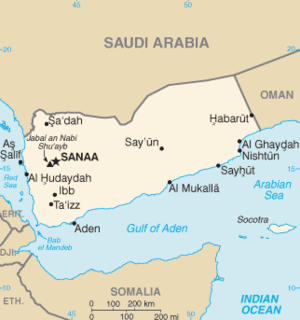1994 Civil War in Yemen
| Yemeni Civil War (1994) | |||||||
|---|---|---|---|---|---|---|---|
| Part of Effects of the Cold War | |||||||
 Map of Yemen |
|||||||
|
|||||||
| Belligerents | |||||||
|
|
Supported by: |
||||||
| Commanders and leaders | |||||||
|
|
|
||||||
| Casualties and losses | |||||||
|
931 soldiers and civilians killed |
6,000 fighters and 513 civilians | ||||||
|
7,000–10,000 dead |
|||||||
Yemeni nationalist victory
![]() Republic of Yemen (North Yemen)
Republic of Yemen (North Yemen)
Supported by:
![]() Brigadier General Ali Mohammed Assadi
Brigadier General Ali Mohammed Assadi
931 soldiers and civilians killed
7,000–10,000 dead
The May–July 1994 civil war in Yemen was a civil conflict waged between the two Yemeni forces of the pro-union northern and the socialist separatist southern Yemeni states and their supporters. The war resulted in the defeat of the southern armed forces, the reunification of Yemen, and the flight into exile of many Yemeni Socialist Party (YSP) leaders and other separatists.
The Republic of Yemen (ROY) was declared on 22 May 1990 with Ali Abdullah Saleh becoming President and Ali Salim al-Beidh Vice President. Greater Yemen had been politically united for the first time in centuries. A unification of the two countries' political and economic systems was to take place over 30 months. In that time, a unified parliament was formed and a unity constitution was agreed upon. Elections were held in April 1993.
...
Wikipedia
